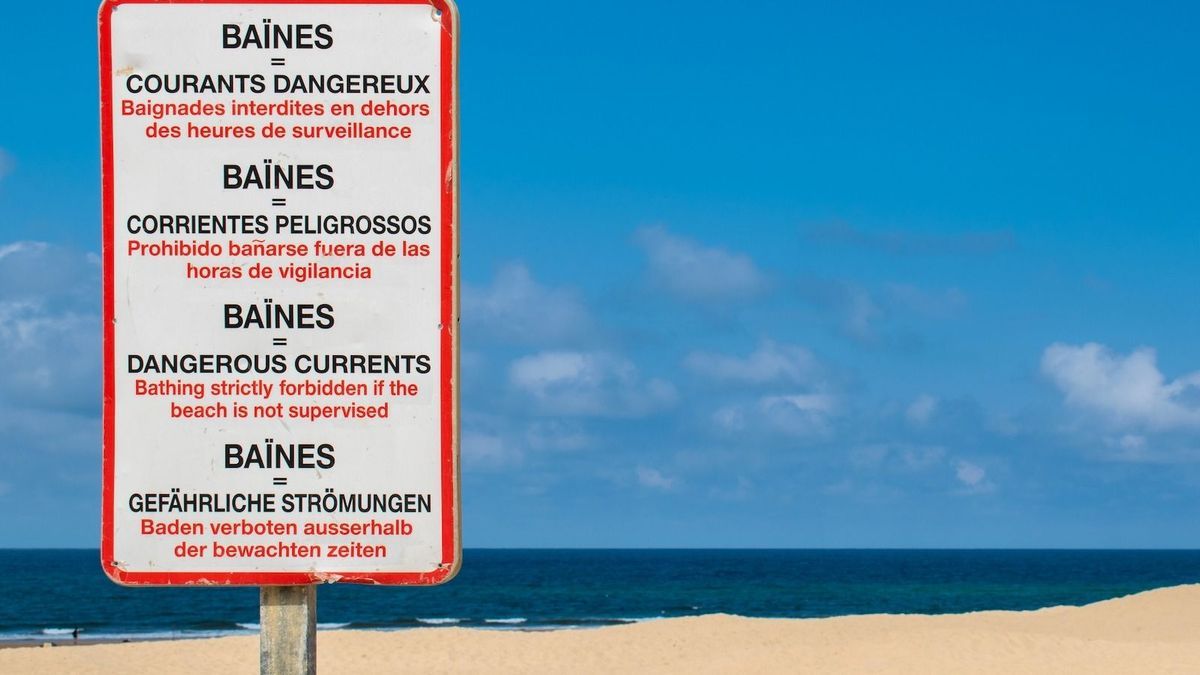
The Augustians have arrived at their destination. On the program: sunbathing, visiting monuments or even swimming in the sea. For these holidays, INRAE is conducting research to better understand the risk of drowning at sea, which is particularly important in the South-West because of the currents of the “baïnes”. The objective: to prevent it more effectively. Explanations.
Drowning is the third leading cause of accidental death worldwide. According to Public Health France, 233 drownings including 84 deaths were recorded on the territory, between June 1 and June 28, 2023. In recent days, many families have packed their suitcases to go on vacation and enjoy the seaside. South-west of France, the risk of rip currents, more commonly known as “baïnes”, is very high.
The baïnes at the origin of 80% of drownings in the South-West
As INRAE researchers point out, “These powerful currents trap and carry bathers offshore – sometimes up to 500 meters – and are the cause of nearly 80% of drownings on the beaches of the South-West”. This is the major cause of drowning on the coasts.
In partnership with the University of Bordeaux, the CNRS, the New Aquitaine Region and the Joint Syndicate for the Management of Landes Bathing (SMGBL), researchers are studying the risks associated with swimming in the ocean at a beach in the town of Vieille-Saint-Girons, to better understand and prevent them.
Better understand the risks of swimming at sea
In order to build an effective forecasting model and thus better understand the risks of swimming in the ocean, a team of researchers – from the SWYM project – are collecting data on drowning accidents in the south of the Landes, on the beach of the Lette Blanche, one of the many areas in the South-West prone to baïnes. To do this, the researchers use a reading grid comprising three criteria for assessing the risk of bathing:
- Is there current? (it is a hazard);
- How many people at the beach? (this translates the exposure);
- How do swimmers behave in the face of danger? Is swimming supervised? (these are elements of vulnerability).
“Why do people go swimming that day? What is their perception of risk? We ask people such questions and then relate them to personal and environmental characteristics. Are they adjusting to the danger? Do they think they can swim well? Do locals feel they know the area better than tourists, and therefore expose themselves to more danger? explained Jeoffrey Dehez, researcher in economics at INRAE Nouvelle Aquitaine Bordeaux, within the Environment, territories in transition, infrastructures, societies (ETTIS) unit.
Towards “Baïnes vigilance maps”
The results of these surveys, carried out in the form of questionnaires with tourists and locals on the beaches, come later “complete other indicators, such as topographic surveys that measure the nature of the seabed, the coordinates of GPS sensors installed on buoys to monitor currents, or even drones and cameras installed to study surface currents and frequentation of the sea respectively. beach”.
“By adopting this approach combining physical sciences, oceanography and human and social sciences, all in close collaboration with the local rescuers of the SMGBL, the researchers of the SWYM project have developed an unprecedented multidisciplinary method”specifies the INRAE, before adding that “in the field, rescuers benefit from the observations of scientists, and this method could, in the long term, help to design models for predicting swimming risks, like what exists in the mountains with avalanches, for example” .
Experimental devices
In order to better measure the risks, Jeoffrey Dehez explains that the rescuers have been equipped with digital tablets and that remote entry and interrogation interfaces have also been developed. They allow rescuers to “identify tall their interventions and the associated conditions, in particular those that do not lead to management by the health system. That is to say all those times when the lifeguards warn people about the nature of the danger, when they help a bather very close to the edge, that they bring him back before the situation becomes dramatic). These observations today completely escape the bases of available medical data. And yet they represent the vast majority of the activity of a surveillance post and, therefore, the best measure of risk”, explains Jeoffrey Dehez. Rescuers from Charente-Maritime have also been experimenting with this data collection since the start of the summer season.
However, the project’s team of researchers discovered that these experimentation models have a limit. “These aggregate all the risk components (hazards, exposure, vulnerability), ultimately making little distinction between each of these. They thus tend to trigger alerts when the beaches are very busy (in other words, when exposure is high), whereas the rip currents (the hazard) can be weak. A better understanding of these components makes it possible to avoid desensitizing the population by triggering the alert in the absence of danger, even miss an essential alert on a day of low attendance.”
The final results of the SWYM project are scheduled for autumn 2024. The scientists of this study wish to continue their research in the New Aquitaine region, but also on other coastlines such as Brittany or the Mediterranean (areas potentially concerned by rip currents).
Baines: how to react?
If you plan to swim in the South-West of France, INRAE reminds you of the good things to do if you are caught in the current of a baïne:
- Try to keep calm and not panic;
- Do not fight against the current, you will exhaust yourself;
- Let yourself be carried by the current without resistance;
- Signal your presence with visible arm movements;
- “When the current weakens, get out of the danger zone by swimming parallel to the beach, to the left or to the right”, explains INRAE.
